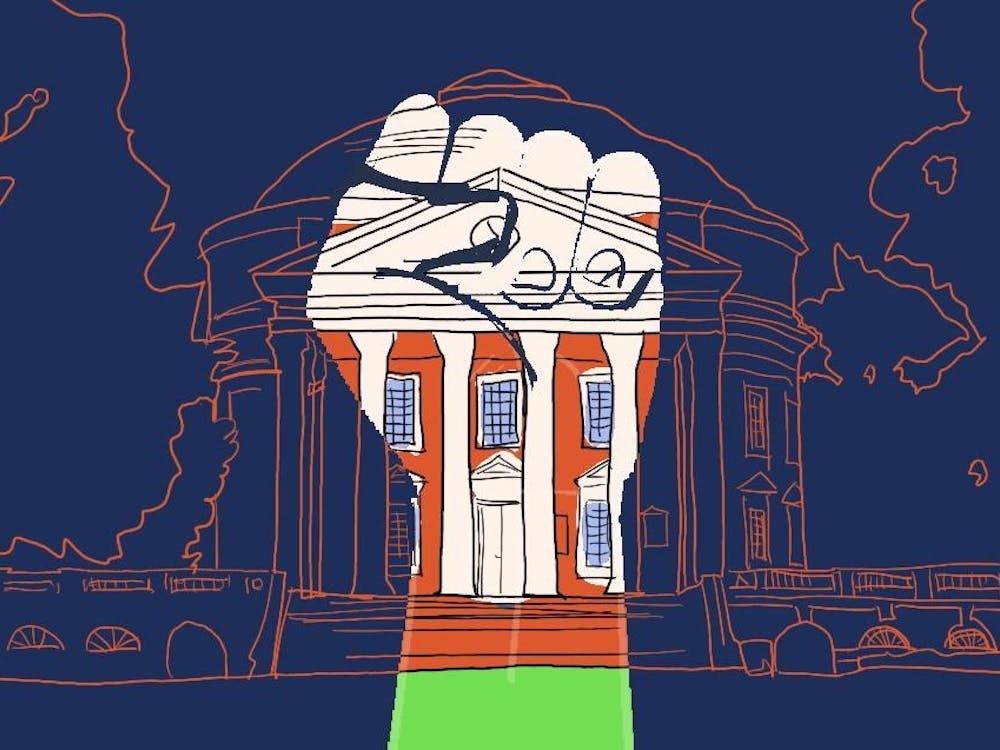The undergraduate McIntire School of Commerce, or “Comm School,” continues to reject more and more applicants each year. Acceptance rates have been precipitously dropping, striking a new 5-year low with 2014’s 57 percent offer rate, down from the 63 percent of 2013 and the 68 percent from just four years ago. McIntire’s B.S. in Commerce numbers among several application-based majors in the University, which include the Batten School’s B.A. in Public Policy and Leadership, the neuroscience major and the Political Philosophy, Politics, and Law major, all of which students generally enter in their third year. All of these are competitive, but I’m going to take McIntire as my case example because it seems the most visible and egregious offender: too many people are applying to McIntire, not enough are getting in. This is a problem.
The issue with the lowering Comm School admission rate stems from how arduous — both extracurricularly and academically — the application process is. Two hundred and fifty students in 2014 took seven requisite courses, besides existing College requirements and disregarding AP credits, but were rejected. Those seven courses are almost an academic year’s course load. Those seven courses cost those students about $20,000 for in-state and $45,000 for out-of-state. And yes, while the prerequisites are valuable learning experiences regardless of application success, they are serious monetary investments that went to waste.
But even more serious than any financial cost is the academic opportunity cost those students incurred. Rather than taking Comm School prerequisites, those students could have explored other departments or taken higher level courses. I’m especially thinking of COMM 1800 and COMM 2010 and 2020, which have no crossover with other majors. Very GPA-intensive admissions exacerbate the problem even more — the mean GPA for accepted students being 3.71 compared with the 3.258 for the entire College. This need for a high GPA greatly incentivizes applicants to build their course loads around Comm School prerequisites, taking low level, non-prerequisite courses and the easier prerequisite options (MATH 1210 instead of MATH 1310, for instance) to inflate GPAs.
Optimal application strategy thus cripples students’ options upon rejection, as students may not have enough credits for some course-heavy majors, and College students must declare a major by the fifth semester. Easy prerequisites and high GPAs entice applicants with dreams of McIntire, but in reality, scores of them won’t have a place and scores of them will be left without options. As a consequence, rejected Comm School applicants funnel into majors that follow from the prerequisites, like Economics, regardless of whether or not that’s their interest. This lack of options extending from Comm School rejection is a glaring failure of the University’s to protect its student body.
The need to display “work experience, co-curricular activities, and the desire for a successful business career” also hampers students’ options upon rejection. The necessity of work experience precludes the possibility of summer academic research for applicants, robbing them of possible research interests and intimate faculty relationships. Also, the pressure to demonstrate the “desire for a successful business career” drives students to invest in business-related clubs and activities that can sour post-rejection.
This is always going to be a problem as long as McIntire requires an application, and the rising application numbers are easily explainable: the students of today grew up with the Great Recession: jobs are on their minds. However, the University can treat this waste of student effort, either by increasing the number of spots for students — an untenable idea in the short run given the pressure it would place on existing McIntire resources — or by working to disincentivize applications in the first place.
The University can try to suppress interest in the Comm School by cutting McIntire advertising and better promoting other majors. But along with the lowered application numbers might come a decrease in applicant ability and national standing as strong students opt out of McIntire. McIntire could also morph into a four-year undergraduate school, like the University of Pennsylvania’s Wharton. However, enrolling business students right out of high school necessitates extreme changes in McIntire’s curriculum and infrastructure along with hurting students from inferior high schools.
Thus, the only option to better make demand for Comm School meet supply is to kick students off the pre-Comm track sooner so that they can prepare for other majors. There are really several ways we could accomplish this. McIntire could post more transparent admissions data — especially mean grades for each prerequisite course — so that students could evaluate their chances of admission more accurately. Academic advisors could more honestly evaluate students’ chances of admission. The University could increase the difficulty of prerequisite courses — only 6% of students taking COMM 1800, for instance, will get a C according to Koofers, an absurdly low number — to more clearly communicate students’ chances. Finally, McIntire could just cut the number of prerequisites so prospective applicants could more easily explore other interests.
But whether it’s one of these or a combination of all, something needs to be done. McIntire, admissions cycle after admissions cycle, is laying waste to the first two academic years of hundreds of students. That’s both cruel and inefficient, and that time can be put to better use.
Brennan Edel is an Opinion columnist for The Cavalier Daily. He can be reached at b.edel@cavalierdaily.com.






